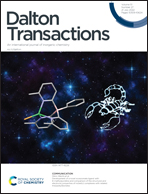Bichromophoric ruthenium(ii) bis-terpyridine-BODIPY based photosensitizers for cellular imaging and photodynamic therapy†
Abstract
Two multichromophoric homoleptic ruthenium(II) complexes [Ru(tpy-BODIPY)2]Cl2 (complexes 1 and 2, tpy = 4-phenyl-2,2:6,2-terpyridine, BODIPY = boron-dipyrromethene) were prepared, characterized and their phototherapeutic activity and bioimaging properties were studied. The complexes having structural similarity differ only by a phenylethynyl linker, and its overall influence on their physicochemical and photobiological behavior was evaluated. The terpyridine-BODIPY ligand L1 was structurally characterized by X-ray crystallography. The complexes showed intense absorption near 500 nm (ε: ∼1.5 × 105 M−1 cm−1 in DMSO), have a high singlet oxygen quantum yield (ΦΔ: ∼0.6 in DMSO), and displayed low photobleaching thus making them suitable for PDT applications. The complexes showed high DNA binding affinity and induced DNA damage on light activation via multiple types of ROS production. Confocal laser scanning microscopy experiments revealed their incorporation in the cancer cells and complex 1 predominantly accumulated in lysosomes. The complexes displayed a significant PDT effect in cancerous cells with visible light activation with a high photocytotoxicity index (PI) value in HeLa cells. Both type-I and type-II photosensitization processes were involved in the PDT effect. The photodynamic action of complex 2 initiated cellular apoptosis. Finally, their diagnostic potential was evaluated against clinically relevant 3D multicellular tumor spheroids (MCTs).



 Please wait while we load your content...
Please wait while we load your content...